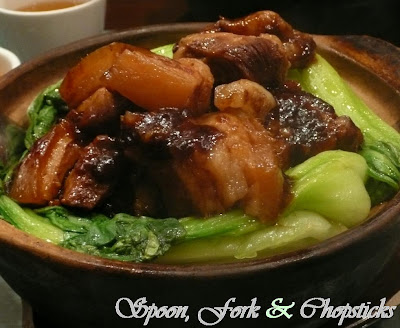Once upon a time before metalware was so proliferative, the Chinese used clay pots of varying sizes and shapes to do the bulk of their cooking – soups, rice, stews, braises, herbal medicinal brews...lots! The clay pots are unglazed and often reinforced by an external wire-netting. Besides from the Chinese producing a lot of earthenware, the pots were popular because of their ability to retain heat and moisture.
One of my favourite winter-warmers prepared utilising this ancient cookware is clay pot rice, known as ‘bo jai faan’ (煲仔飯 – literally, ‘small pot rice’) in Cantonese or ‘guo fan’ (鍋飯) in Mandarin. Traditionally, the pot is pre-soaked in water to help prevent it from cracking and to release moisture during cooking. A small amount of oil is rubbed on the inside surface to prevent sticking and rice is added to be cooked atop a stove of coals or wood. When all moisture has been absorbed by the rice, any manner of accompaniments – pork spare ribs, chicken’s feet, chicken pieces on the bone, dry cured sausage ‘lap cheong’ (臘腸 – literally, ‘wax sausage’), dry cured duck liver sausage ‘yun cheong’ (膶腸), dry cured duck ‘lap ngaap’ (臘鴨 – literally, ‘wax duck’), dry cured pork belly ‘lap yook’ (臘肉 – literally, ‘wax meat’), minced beef and raw egg, minced fish meat, dried mushrooms – are added to steam-cook on top of the rice so that any flavours and oils are absorbed into the top layer. The beautiful part of cooking rice in a clay pot is that you end up with a layer of crispy rice (飯焦) lining the inside of the pot; something not found with modern day, electric rice-cookers. The concept is similar to Korean hot bibimbap, especially when with the combination of minced beef and a raw egg cracked on top (which, by the way, is rarely available now due to the prevalence of avian flu in Asia).
The traditional method of preparing clay pot rice is time-consuming and not conducive to high turnover for businesses, so it is now more common to find rice and accompaniments pre-cooked and dumped into preheated clay pots to steam within before being served. Still, the contents are sizzling when placed on the table and there is a flourish of steam when the clay lids are removed by waitstaff. The Chinese usually add a drizzle of light soy sauce and mix up the contents before they begin to eat clay pot rice – this helps mix any fats through the rice and prevents the crispy outer layer of rice from burning.
On a cold week in Sydney, Gingerbreadman suggests we have clay pot rice at a place he knows of at Eastwood. It’s a small shop with a garish yellow sign and Chinese glass-topped tables and stools within. The furniture reminds me of that found in Chinese herbal stores or Cantonese dessert stores. We wait for Dr King and Kiki to arrive before ordering and it is only a short while before we are brought our collection of clay pots.
Between us we have clay pot rice with ‘mixed wax meats’ (dry cured sausage, duck liver sausage, pork belly and duck) (臘味煲仔飯) and another with the addition of mushrooms and chicken (冬菇滑雞臘味煲仔飯). The fat and salt from the meats give flavour and a sheen to the rice grains. It is greedy food for cold, cold weather. Can you see the rice crisping up on the left there?
We also have clay pot rice with braised pork belly (紅燒豬腩煲仔飯) which is really tasty. The meat is fall-apart tender with soy sauce flavours deeply infused.
Then there is also clay pot wide rice noodles (‘hor fun’) braised with beef and vegetables (菜遠牛肉煲仔河粉). This is an interesting one for me as I’ve never had noodles from a clay pot before, and the heat retained in the dish is amazing.
We hardly have enough room on the little table for all our pots and busily scrape off crispy rice bits whilst trying not to burn our tongues. We are warm and happy and leave with our cheeks glowing a rosy hue.
Hot Pot King (煲煲旺)
Eastwood Village, Shop 32, cnr Lakeside Rd & Progress Ave, Eastwood NSW
Tel: (02) 9874 5508
Opening Hours: 7 days, I would expect

*EDIT*: As of early 2010, Hot Pot King is closed for business.
happy eating!




Ohhhh! I love a good claypot meal. The food stays hotter for so much longer (essential when you eat as slowly as I do) and there's always that delicious crispy layer at the bottom of the dish to scrape away and munch on. I'll have to stick this into my little book of "To-Eat-At" places for a chilly and wet weekend :)
ReplyDeleteOh this is so funny! My mum has made claypot as long as I can remember and it's never actually been a clay pot. Always in a pressure cooker or a regular pot. They're so lovely and warming aren't they! :)
ReplyDeleteoh my god. Claypot rice. I have not had these in like 8 years. I think I am swooning, because all I can think and see now is those amazing pots of guo fan!!!
ReplyDeleteHi Shez! Thanks for dropping by and leaving a comment =D There's definitely a nostalgic factor involved in that crispy rice layer - comfort food of a different type.
ReplyDeleteHey Lorraine, often 'clay pot' rice at yum cha these days is stainless steel pot rice... Has to do with durability, I believe!
Hey Sophia, you are long overdue for a fix! Look for some as the weather gets colder where you are =)